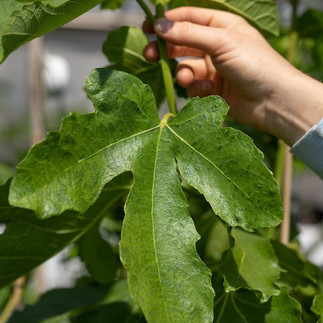Fig Mosaic Virus: Identification, Treatment & Concerns
- Ross the Fig BOSS

- Dec 7, 2023
- 3 min read
Updated: Jul 2, 2024
Fig trees have been loved throughout history for their tasty fruits, ease of care, and iconic appearance, however, they can be susceptible to various diseases, including the Fig Mosaic Virus (FMV). This virus found within almost all fig trees causes mottled, discolored leaves, deformed growth, and reduced fruit quality and yield.
Fortunately, if you suspect your fig tree has severe symptoms, I'll cover a technique called rejuvenation pruning, a powerful way to combat FMV and restore your fig tree to health.
Here's what you need to know.
For more fig-related content like this, feel free to subscribe to the Fig Boss monthly newsletter at the top of the page.
Diagnosing FMV:
Visual Symptoms:
Mosaic Pattern: Irregular patches of, yellow, light green, and dark green on leaves.
Strange Growth: Distorted, deformed, or stunted leaves and branches growing in odd directions. The fruits are unaffected.
Please note: Browning of the edges of the leaves and total yellowing of leaves are frequently caused by poor watering practices. Brown spots are likely caused by another disease called Rust, and bronze or brown streaking is likely caused by sunburn.
If you want me to diagnose your leaves, feel free to send me some photos through the Fig Boss contact form. Once I respond, you'll be able to attach photos.
The Negatives of Fig Mosaic Virus:
These symptoms make it harder for the affected leaves to photosynthesize and gather energy, leading to several other problems:
Decreased Fruit Quality: Flavor and sweetness may be impacted.
Chronic Infection: The virus persists and weakens the tree.
Poor Productivity: Reduced fruit yield.
Limited Lifespan: Severe cases can shorten the tree's life.
Understanding the Virus at a Deeper Level
Fig Mosaic Virus (FMV) is a complex and controversial topic among knowledgeable fig growers. Much remains unclear about its impact and management, often leading to conflicting information online. While some sources, including the University of California Agriculture and Natural Resources, recommend discarding infected trees, many experienced growers believe this is unnecessary and even wasteful.
The virus, spread by microscopic mites rather than mechanical means like pruning, is likely present in all fig trees to some degree. However, the severity of symptoms and the impact on fruit production can vary significantly. The good news is that several promising strategies may help lessen or even eliminate FMV infection.
One such strategy is rejuvenation pruning. This technique involves removing weak and infected growth, encouraging the development of vigorous shoots and a healthier framework. This approach is both economical and effective, promoting overall tree health and potentially reducing FMV symptoms without the need for chemicals.
A commercial grower named Brent, who I highly respect, believes that controlling the mites that spread the virus is crucial. While cold temperatures can kill some mites, their precise tolerance range is unknown. Other methods, like soaking cuttings in bleach or thermotherapy, seem impractical for most fig growers. Interestingly, even spraying with miticides is considered a last resort by many, with rejuvenation pruning often preferred for its effectiveness and cost-efficiency.
The conflicting information surrounding FMV highlights the need for further research and collaboration among growers and researchers. While discarding infected trees may appear straightforward, it ignores the potential for recovery and can be wasteful. By exploring alternative methods like rejuvenation pruning, we can develop more sustainable and effective solutions for managing FMV and ensuring healthy, productive fig trees for years to come.
Rejuvenation Pruning for Renewal:
This technique involves strategically cutting away infected and unwanted growth to encourage strong, healthy new shoots.
Benefits:
Combats FMV: Eliminates infected growth, reducing the virus's presence.
Promotes Healthy Growth: Stimulates vigorous new shoots.
Increases Productivity: Higher fruit yields as the tree recovers.
Cost-Effective: More economical than replacing the entire tree.
How to Rejuvenation Prune:
Pruning Strategy:
Identify and remove infected and unwanted growth.
Cut back to healthy wood.
Monitor new growth and provide proper care.
Choose 1-5 new shoots as the healthy base of your fig tree.
Benefits of Rejuvenation Pruning Compared to Other Types of Pruning Fig Trees
Personal Experience:
Rejuvenation pruning has proven effective for stagnant, infected, and low-yielding fig trees. It's become my standard practice after rooting or planting a new fig, ensuring a healthy foundation and maximizing potential.
This method provides a sustainable and efficient solution compared to starting over completely.
Additional Notes:
Consider the tree's age and health before pruning.
Seek advice or assistance if needed.
Patience is key. Rejuvenation takes time, but the results are worth it.
Embrace the power of rejuvenation pruning and watch your fig tree thrive!












